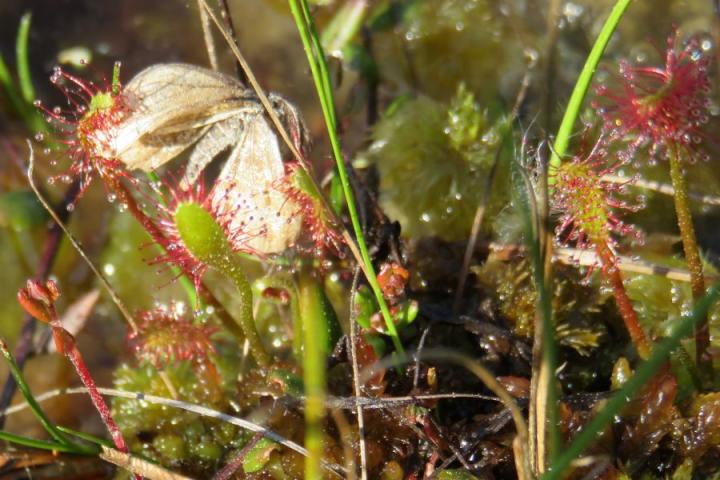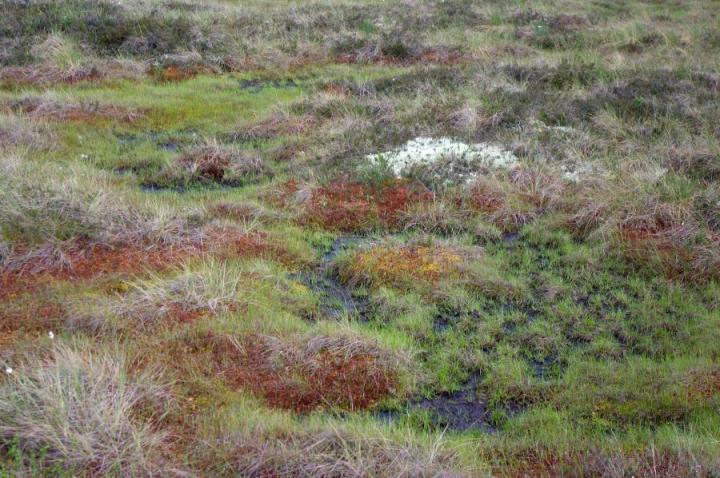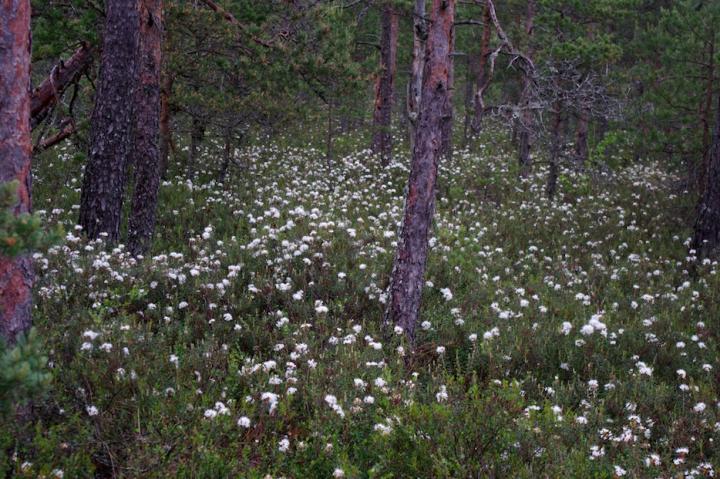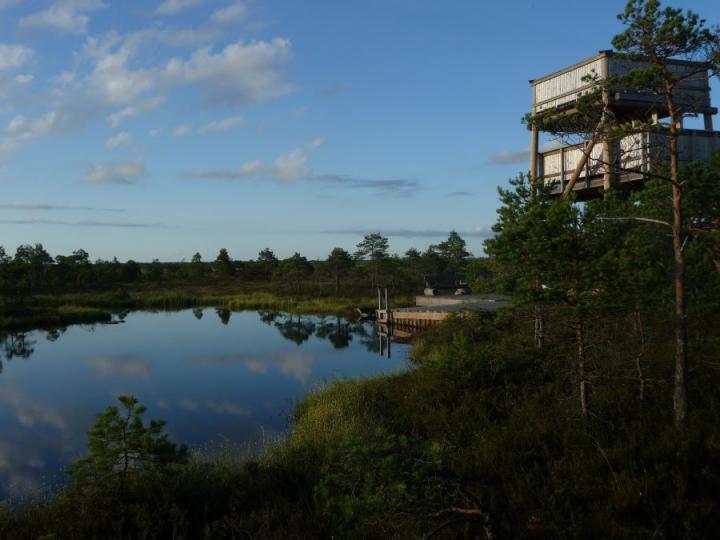Blog - Plant Hunting in Estonia (Pt2)
Following on from part 1 we continue on the trail of discovering interesting plants as Dr Richard Milne and his team of plant scientists explore Estonia.

Author: Richard Milne, Editor: Tea Reinert
During June 2022, a motley crew of ten plant enthusiasts joined forces for a week of plant hunting in Estonia. During the first two days, they arrived in dribs and drabs from various directions, and in an earlier blog I described our explorations of boreal woods within the limits of the capital city, Tallinn.
Finally, on the Saturday, we had the full party assembled. We set off in two cars, keeping an eye out for storks in the fields by the roadside, or standing proudly on the huge nests that they somehow manage to balance upon telegraph poles. Our first destination was the huge raised bog at Marimetsa, where we parked near a fine plant of Berberis vulgaris. The walk to the bog offers plentiful interest, passing through a series of distinct habitats. First comes a strip of alkaline meadow, where interesting species include the semiparasitic Thesium ebracteatum (rare in Estonia and absent from Britain), the fragrant orchid Gymnadenia conopsea, Plantago media, Filipendula vulgaris, and many others. Passing next through limestone woodland, we saw Hepatica nobilis and Daphne mezereum, both spring plants that had long finished flowering, sadly. Then we crossed a peaty meadow, pausing to marvel at the abundance and diversity of pollinators that were visiting flowers at the field edge. Besides the plants, one of the joys of Estonia is that the insect populations are so much healthier than in Britain; one can encounter five types of dragonfly or damselfly on a casual walk along Pirita river, for example. Also on show were bizarre mutants of the water avens Geum rivale, in which the female flower parts were replaced with stems, and the petals were partly replaced with leaves.

Next, we plunged into deep pinewoods, far denser and darker than the ones around Tallinn, so only the most shade tolerant plants can survive here. These include the one-flowered wintergreen Moneses uniflora with is delicately beautiful nodding flowers, another British rarity in Melampyrum sylvaticum, and the birdsnest orchid Neottia nidus-avis. The last is perfectly adapted to these dark places because it has no chlorophyll at all, getting all its energy by exploiting fungi instead. Then the path turned a corner, the substrate became rocky again and deciduous trees took over. Here the globe flower Trollius europaeus turns up alongside Actaea spicata, more Paris quadrifolia, and the curious Asarum europaeum.
This impressive list of finds was merely the hors d’oeuvres! Now we came onto a specially constructed wooden walkway, allowing us to pass serenely over the wetlands without sinking. The wetlands, too, were divided into zones, with the flora changing as one approached the raised bog proper. First, we passed through a fen-like wetland with a diverse assemblage of species, including two types of dwarf birch, spotted and butterfly orchids, insect-eating bladderworts, and alpine deergrass Trichophorum alpinum, a plant which went extinct from Scotland around a century ago, and is notable for the tiny pieces of fluff on top of its fruiting stems.

Next came a wave of trees, and a mass of white flowered ledum shrubs, now known to be a specialised boreal member of the genus Rhododendron. This species is full of psychotropic chemicals, and my Estonian in-laws tell a tale of a local woman who went out collecting berries on a hot day, but paused for a rest among a mass of flowering ledums, and passed out after breathing in too much of the vapours issuing from them. She was eventually found and rescued by concerned neighbours the following morning, and other than having provided an all-night buffet for the local mosquitoes, was more or less unharmed. The plant is also used in homebrews – according to one Estonian source, “those who wished the drinker to become drunken, staggering, vomiting added ledum to their homebrew ... not everyone can take this.” We kept our interaction with the plant strictly visual.
At last, the pines and ledums began to thin, and we were over the peat bog proper. Now the ground was mainly covered in a mass of Sphagnum moss, probably many different species, each subtly different in its exacting requirements. These mosses also varied in colour from bright green to reddish, lending the landscape a peculiar beauty, and this stretched away far into the distance. In between the moss were peaty pools, and numerous insectivorous sundews popped up on pool edges. How much they got to eat I’m not sure, for the mosquitoes that had been prevalent under the trees seldom seemed to venture out here, or perhaps they did but soon ended up as sundew food. One sundew had even caught a moth. Otherwise, cranberries threaded their wiry stems across the moss, and occasional cloudberries poked through with their pure white flowers. But the mosses are king here, engineering the environment to their own advantage. Sphagnum plants actually pump out hydrogen ions to keep the water around them acidic, impeding decomposition and so ensuring that peat continues to form. Hence the environment remains perfect for them, and difficult for all but a very few angiosperms (flowering plants) to get a foothold.
After a while, the ground below us got even wetter. It’s easy to think of peat bogs as being static places, but a large enough bog can have water flowing through it, and here a watercourse made its sedate way through and under the walkway. Here a very special plant occurs, the Rannoch-Rush Scheuchzeria palustris. It is a plant for the connoisseur – the only living member of its family, and an extreme specialist, for it only occurs in the wetter parts of raised peat bogs. In Britain it now occurs only in hard-to-reach parts of Rannoch Moor, hence the common name. In the Estonian bog watercourse, the Rannoch-Rush is accompanied by some plants of the delicate sedge Carex limosa, and the beautiful and far commoner bogbean Menyanthes trifoliata.

Then the watercourse was behind us, and the sphagnum took control once more, until the walkway ended abruptly in a wide wooden platform, with a two storey watch tower, on top of which my wife and I once spent a night sleeping under the stars, much to the annoyance of an owl who liked to perch there. However, the special thing here is the majestic bog pools. Surrounded by rings of more solid land supporting pines and ledums, the pools are deep and dark with peaty water. On a warm summer day, it is a divine place for a swim, though the water feels cold at first, and there was some gasping and wincing from those (like me) not willing to simply dive in. I swam a lap of the pond and was granted with eye-level views of waterside plants such as the sedge Rhychnospora alba, bog rosemary Andromeda polifolia, and more Scheuchzeria palustris. Sundews continued to dine on any mosquitoes foolish enough to venture out here.
Peat bogs are vital for our planet, not just as reservoirs for special types of plant and animal, but also as carbon sinks. As long as water and acidity from the sphagnum cause peat to form, carbon will be drawn from the atmosphere, helping to mitigate the disastrous effects of fossil fuel burning. We drank in this remarkable landscape from the top of the viewing tower, until it was time to head back to the cars along the wooden walkway.

